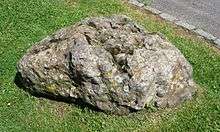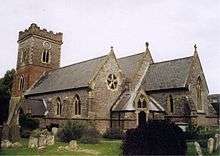Nettlebed
| Nettlebed | |
| Historic pottery kiln |
|
 Nettlebed |
|
| Area | 6.13 km2 (2.37 sq mi) |
|---|---|
| Population | 727 (2011 Census)[1] |
| – density | 119/km2 (310/sq mi) |
| OS grid reference | SU7086 |
| Civil parish | Nettlebed |
| District | South Oxfordshire |
| Shire county | Oxfordshire |
| Region | South East |
| Country | England |
| Sovereign state | United Kingdom |
| Post town | Henley-on-Thames |
| Postcode district | RG9 |
| Dialling code | 01491 |
| Police | Thames Valley |
| Fire | Oxfordshire |
| Ambulance | South Central |
| EU Parliament | South East England |
| UK Parliament | Henley |
| Website | Nettlebed Parish Council |
|
|
Coordinates: 51°34′41″N 0°59′24″W / 51.578°N 0.990°W
Nettlebed is a village and civil parish in the Chiltern Hills about 4.5 miles (7 km) northwest of Henley-on-Thames in Oxfordshire and 6 miles (10 km) southeast of Wallingford. The 2011 Census recorded a parish population of 727.[1]
History


Archaeological finds show that the area around Nettlebed has been inhabited since Palaeolithic times.[2]
The site was frequently travelled through since ancient times, being a pass through the Chiltern Hills used by the road between Oxford and Henley. The road between Henley and Wallingford was made into a turnpike in 1736 and ceased to be a turnpike in 1873.[3] It is now classified the A4130.
The Church of England parish of Saint Bartholomew was originally a chapelry of the adjacent parish of Benson. There is a record of the Empress Matilda giving the benefice of Benson, including chapels at Nettlebed and Warborough, to the Augustinian Abbey at nearby Dorchester, Oxfordshire in about AD 1140.[4] The Mediaeval church building was replaced in 1845–46 by the present building, designed by a member of the Hakewill family of architects.[5] The bell tower has a ring of six bells, all cast by Charles and George Mears of the Whitechapel Bell Foundry in 1846.[6]
From the 14th century Nettlebed became important for brick making, which continued until the 1930s. One remaining pottery kiln is preserved in the village.
The sand used in the manufacture of the first flint glass was sourced from Nettlebed by George Ravenscroft in 1674.
Windmill
Nettlebed had what seems to have been the only smock mill in Oxfordshire.[7] It used to be at Chinnor but was moved to a windier site at Nettlebed in about 1825. It was a slender octagonal building with four common sails and a fantail. It burned down in 1912.[8]
Nettlebed Folk Song Club
The village is home to a long-established and highly regarded folk club which holds its concerts on Monday evenings from 8pm at The Village Club in Nettlebed High Street.
Nettlebed Folk Song Club was started in July 1975 at the Bull Inn. The club quickly became established as one of the folk music scene's major venues. When the Bull Inn was closed by its owners, Brakspear Brewery in 1991, the club moved to its present venue, which holds 200 people.
The Folk Song Club is a volunteer run, non-profit organisation which has featured many notable singers and musicians such as Altan (at least seven times: in 2006, 2007, 2009 (two times!), 2010, 2012 and 2014), Eric Bogle, Martin Carthy, Fairport Convention, Vin Garbutt, Bill Jones, John Kirkpatrick, Lindisfarne, Ralph McTell, Show of Hands, Steeleye Span, Richard Thompson.
The Club is also famous for its unique special performances such as 'Feast of Fiddles' and 'Rocks Specials' where a mix of leading national performers and local artists provide themed evenings.[9] Nettlebed Folk Song Club is recognised as one of the top folk venues in the U.K. and in 2002 won the prestigious BBC Radio 2 Folk Club of the Year Award.[10]
Notable residents
- Celia Johnson, star of the 1945 film Brief Encounter.
- Lucy Fleming, actress
- Peter Fleming, writer and traveller
- Kate Grimond née Fleming, daughter of Celia Johnson, writer and actress, daughter-in-law of Jo Grimond
- The Duke and Duchess of Kent
In 2012, St Bartholomew's church was the venue for the wedding of Thierry Kelaart to Patrick Heathcote-Amory, son of Sir Ian Heathcote-Amory: Michael Middleton acted as father of the bride and guests included the Duchess of Cambridge.[11]
See also
References
- 1 2 "Area: Nettlebed CP (Parish): Key Figures for 2011 Census: Key Statistics". Neighbourhood Statistics. Office for National Statistics. Retrieved 1 December 2013.
- ↑ Nettlebed - a Brief History
- ↑ Turnpike Roads in England
- ↑ Page 1907, pp. 87–90.
- ↑ Sherwood & Pevsner 1974, p. 714.
- ↑ Davies, Peter (17 January 2007). "Nettlebed S Bartholomew". Dove's Guide for Church Bell Ringers. Central Council of Church Bell Ringers. Retrieved 1 December 2013.
- ↑ Foreman 1983, plates 66, 67.
- ↑ Foreman 1983, p. 127.
- ↑ Nettlebed Folk Song Club, retrieved 7 February 2011
- ↑ "Previous wnners". Radio 2 Folk Awards 2006. Retrieved 7 February 2011.
- ↑ "Kate and the Middletons all smiles at wedding of family friend". Daily Telegraph.
Sources
- Foreman, Wilfrid (1983). Oxfordshire Mills. Chichester: Phillimore & Co Ltd. p. 127. ISBN 0-85033-441-1.
- Page, W.H., ed. (1907). "The Abbey of Dorchester". A History of the County of Oxford. Victoria County History. 2: Ecclesiastical History, etc. Westminster: Archibald Constable & Co. pp. 87–90.
- Sherwood, Jennifer; Pevsner, Nikolaus (1974). Oxfordshire. The Buildings of England. Harmondsworth: Penguin Books. pp. 714–715. ISBN 0-14-071045-0.
External links
![]() Media related to Nettlebed at Wikimedia Commons
Media related to Nettlebed at Wikimedia Commons
